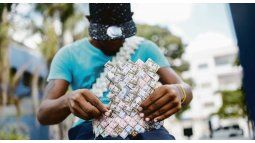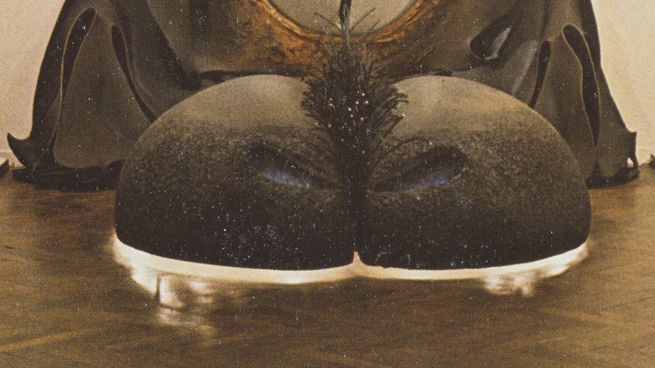“Alienígena”, in the Amalita collection of the Fortabat Museum, is the first brilliant exhibition dedicated to the Mendoza creator, who was a pioneer in many ways and who ended up marginalizing himself.
Upon entering the Amalita Collection where it is presented “Alien. “Emilio Renart and his artistic and social practice”the artist’s first retrospective exhibition, the viewer discovers an art that, although it has a certain proximity to informalism, differs from the expressions close to Pop of the Torcuato Di Tella Institute and also from those of the rest of the artists of his time. Renart is a rarity. The exhibition, curated by Sebastián Vidal Mackinson, meant exhaustive work and required around three years of firm research in the public archives.in addition to the search for works in private hands.
The content you want to access is exclusive to subscribers.
Emilio Renart (Mendoza, 1925-Buenos Aires, 1991) It is not that far away in time, but it has been absent in memory. And access to his strange work was always difficult. From the striking series “Integralism. Bio-Cosmos” Made between 1962 and 1967, not everything is preserved. There are the first two works that make up the collection of the Modern Museum and that, added to an extensive production of paintings, drawings and sculptures, provide a clear testimony of the artist’s genius.


Emilio Renart, an artist to rediscover
The Fortabat exhibition opens with the spectacular “Bio-Cosmos 3”, a feminine sex with volume, and very hairy, like much of his drawings. The central part is guarded by the Provincial Museum of Fine Arts of La Plata, the two large sides were lost. With this work he won the National Prize of the Di Tella Institute in 1965, whose jury was made up of the famous American theorist Clement Greenberg, the Frenchman Pierre Restany and Jorge Romero Brest.
In reality, the perception of the excellence of the aesthetic values of Renartwas expressed in its time by several experts, from Aldo Pellegrini, who clarified: “Any descriptive intention is not enough to give the strength, the originality, the fantasy of these works that unite the abstract and the vital in a surprising way.” Among the critical texts is that of the sculptor Juan Carlos Distéfano, who describes the sending of Renart to the IX San Pablo Biennial. Distéfano speaks of a “revulsive, illuminating work that went unnoticed because it did not fit within the schemes emanating from the great cultural capitals.”
Between 1968 and 1976, “tired of indifference and hyper-competition,” Renart He abandoned artistic production to dedicate himself to teaching, and settled in France for a few months thanks to the Braque Prize scholarship.
Through the journey of the series that goes from the late 50s to its latest productions, Vidal Mackinson points out the crucial importance of the role that “creativity” plays in the work and also in Renart’s life. On the other hand, in a group where abstract production dominates, the figurative condition of some works made during the military dictatorship. There is your mysterious “Self-portrait” and the enclosed human silhouette of the formidable sculpture “Obverse – Reverse”.
Renart was a silent figure, similar in this sense to his friend, Rubén Santantonín, the author of the famous “cosos”. But when in 1983 he presented an exhibition at Espacio Giesso, the critic Hugo Monzón heard him speak and invited him to the Sívori Museum to teach a course on Introduction to Creativity. Thus he spread his ideas about “the facets of creation” that reach all men, whether or not they are artists. “If this is the case, I think the fact of being born is more than justified.”he maintained.
The 30 registered in the first month grew to 120. Thus, several groups emerged and in the Buenos Aires art scene people were talking about Renart at that time. Maybe because he never lost sight of communication, affection and other vital issues. The complexity of his ideas was finally put into the book. “Creativity”published in 1987. On this topic, the curator of the exhibition says: “I want to read his texts in the exhibition and activate some Introduction to Creativity exercises that he did at the Sívori Museum between 1985 and 1988. A student told me that “His energy grew and grew as he met his students.”
“’Alien’ is not a reference to those originating from other worlds or planets. In this retrospective – the curator clarifies – the word indicates the strange condition of a practice that operated in the Buenos Aires scene in a forceful way.. In the last room are the “Multiimages”more than a hundred 25 cm sculptures made of expanded polyurethane, waste materials and wood, which he presented at the Ruth Benzacar gallery in 1989. Renart aspired to present the variety of forms with uniform materials. “Since thinking is so variable, images should not be repetitive”noticed.
Source: Ambito
I am an author and journalist who has worked in the entertainment industry for over a decade. I currently work as a news editor at a major news website, and my focus is on covering the latest trends in entertainment. I also write occasional pieces for other outlets, and have authored two books about the entertainment industry.




